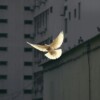Cave paintings and rusty ochre brushstrokes appear on the cover of Darrel R. Falk’s recently published book, On the (Divine) Origin of Our Species.1 These earliest examples of art call out to us today. Falk describes the European cave paintings in the Chauvet caves, of horses, rhinos, and lions, which were discovered in the twentieth century. As a Christian and a biologist, Falk asks what the European artworks mean.
I have asked the same questions, as a Christian and a chemist, about similar cave paintings that likewise merge art, biology, and chemistry. My starting point is the Sulawesi Warty Pig, which is part of a set of very old cave paintings, discovered very recently. My ending point is similar to Falk’s in almost every respect – but for one. Part 1 describes how my chemical imagination and Falk’s biological imagination coincide as we look at the earliest art as scientists. Part 2 will discuss the one way in which we differ.
My starting point is late-breaking news – it has only been known since 2017, when an Indonesian grad student named Basran Burhan, exploring the island of Sulawesi, followed a hunch and found a hidden valley.2 There the cave walls preserved remarkable works of art, displaying purple and red strokes of pigment that formed the shape of the local wild “warty pig.” These artistic treasures were close to the surface, not too deeply buried, peeking out from the rock like the colors of an Easter egg, or like the treasure hidden in the field in the parable. It’s like someone wanted us to find these out.
This Indonesian cave art turns out to be the oldest representational art found so far, older than European cave art. Human hands painted the warty pig 45,500 years ago as opposed to the 30,000-year-old European paintings.3 Burhan and colleagues recently found other paintings more than 50,000 years old depicting more pigs and “therianthropes” (human figures with composite animal features).4 These “imaginary” creations are the oldest evidence of the human imagination. A mind that could imagine gods could one day imagine the Kingdom of God.
I’m compelled by love of my own discipline to point out how both the European and Indonesian caves were preserved by chemistry. Limestone, which easily dissolves in water, laid down a thin, transparent layer of rock over the pigments, like a windowpane. This limestone served as a natural varnish, protecting the art from the elements while letting light through. Without the special chemical properties of limestone, the paintings would have been lost, so we owe this insight into our own evolution to chemical mechanisms that we can imagine.
The imagination that led the artists to paint and the post-doc to explore his hunch, this same imagination lets chemists calculate the paintings’ age from the uranium isotopes. Throughout his book, Falk shows how, as a biologist, he imagines the evolution of imagination itself. All of these forms of imagination are windows through time and into a deeper reality that the mind can perceive and represent.
Falk’s book is all about our window into this deeper reality: when our species began (Chapter 3); when imagination began (Chapter 4); when the intentions of others were imagined, resulting in cooperation (Chapter 5); when the past is imagined in terms of God’s intentions (Chapter 6); and when the future is imagined in terms of God’s purposes (Chapter 7).
In Chapter 4, Falk describes the origin of artistic imagination by quoting another scholar: “’It was not a primitive beginning or slow evolution, it burst onto the scene like a sudden explosive event. It is as if the modern human soul has awakened here.’ … By this time, 35,000 to 37,000 years ago, members of our species were reaching out beyond themselves. Given our faith in the God who is love, we can safely assume that the Spirit in turn was reaching out to them – however opaque their understanding of the spiritual reality that they were seeking to take hold of.”5
Through his book, Falk works to reconcile the sudden explosive event, the creation of creativity, with the slow, incremental changes of genes found by biological science. This “horizontal” reconciliation coincides with Falk’s work toward a “vertical” reconciliation, between humans and God. Falk writes that prehistoric artworks are evidence of spirituality, that “these early members of our species were reaching out to the Divine because the Divine Spirit was reaching out to them.”6
Each of Falk’s two directions of reconciliation challenges the assumptions of a different group of twenty-first-century humans. To the Christians who reject evolution, he argues that a Trinitarian theology can be reconciled with mutations in particular genes for cooperation, as the Spirit worked through evolution to “domesticate” our selfish animal instincts so that ancient artists could imagine the unimaginable God.7 To scientists who reject the resurrection, he offers “an alternative hypothesis about reality”: “the best explanation of the data at hand” is that “Jesus died and rose again.”8 Falk insists, with all the saints, that the primary basis of reality is more than reductionist science can grasp or comprehend, much more than we can ask or imagine. The Spirit figures prominently in Falk’s account.
Falk discusses genes and mutations but maintains that the key to the first imaginative explosion was not primarily a physical addition but involved a certain “emptying” or self-denial. As theologians as far back as Gregory of Nyssa have noted, many animals have physical and biological capabilities that well exceed ours. Anyone who had the wings of a bird, the strength of an ox, and the antlers of a deer would “be a wild-looking and formidable creature; then, moreover, he would have neglected his rule over the others, not needing the cooperation of his subjects; but as it is, for this reason the needs of life are divided among each of those subjugated to us, to make our rule over them necessary.”9 To Gregory of Nyssa, and to Falk, the dominion commanded in Genesis 1:26 is a sign of our physical weakness, not strength, so that we need the strengths of other creatures, and of other humans. Dominion goes along with domestication and cooperation – and we humans are domesticated too, albeit self-domesticated.
It was not a physical addition but a metaphysical subtraction that led to the creation of art tens of thousands of years ago. The physical addition of brainpower was necessary but not sufficient. The brainpower had to be held back and corralled somehow. According to Falk, “Sapiens were able to inhibit the neural circuitry associated with emotions – to plot out a best course of action that is not based purely on a ‘gut response.’”10 For example, the “anxiety of death-awareness”11 is something to be held in check, so that early humans were “held in slavery by their fear of death” (Hebrews 2:15 NIV), needing someone to set them free.
To support this, Falk quotes from the anthropologist Terrence Deacon’s book The Symbolic Species, in which Deacon describes how this “addition by subtraction” creates meaning in language. (In Deacon’s Incomplete Nature, he even imagines a model for the chemical origin of life through such “addition by subtraction”!12 ) When the scientific imagination envisions genes and species, we call that “biology,” and when it imagines atoms and reactions, we call that “chemistry” – but these are really one thing, aren’t they?
Falk cites Deacon to explain our “built-in curiosity” and “predisposition to search for meaning … from an outside source.”13 Blaise Pascal described this inclination as the “God-shaped hole” in each of us. Everyone feels that there’s a piece missing and must imagine how to reach out through the imagination because God is spirit and must be worshiped in spirit and in truth.
When we reached out, we found each other, so we formed communities. Some communities expressed their search by painting beautiful images on cave walls. Those who still needed something more, something not object but spirit, would eventually reach out to God. Falk argues these out-reaching humans would find that God was reaching back to them. Once “they had chosen to live in harmony with the Spirit of God,”14 they would be able to imagine the divine, and would themselves become the very images of God.
They would also be able to imagine the mind of their neighbor, developing both cooperation and competition, planned cities and planned wars, and a knowledge of good and evil. If communities can choose to reach out to God, then they can also choose to turn away from God. This leads to Falk’s view of how original sin can “spread like a virus not through genetic transmission, but as a cultural condition into which we are all born.”15
Needless to say, Falk is not attempting to pin down the GPS coordinates of the Garden of Eden. Instead, he argues that, in the mindset of the original author of Genesis, Eden is “not located somewhere on Earth but represents the whole earth.”16 If Eden is reimagined as the whole earth, then the artistic spirit may have awakened on opposite sides of the globe 50,000 to 40,000 years ago. The cave art could be both cause and effect: the artist who imagines invites others to see what she has painted17 and provokes the imagination of anyone who enters the cave and sees the painted images moving in the flickering light.
All art, whether on cave walls or paper pages, sparks the imagination in a similar way. George MacDonald wrote, “God sits in that chamber of our being in which the candle of our consciousness goes out in darkness, and sends forth from thence wonderful gifts into the light of that understanding which is His candle.”18 MacDonald created stories set in fantastic worlds that inspired C.S. Lewis and J.R.R. Tolkien to imagine the worlds of Narnia and Middle-Earth.19 One might imagine a prehistoric MacDonald painting a human with an animal head on a cave wall 50,000 years ago, lighting candles of consciousness. The triune God, fully human and fully divine, is the Light of the World, the original candle of consciousness.
The ancient cave painters, the Christian literary world-makers, and the modern scientists all reach out. Falk’s imagination ties the science together in a way that reaches out to a deeper, eternal reality, one in which the Creator of all this was also a human who lived and died, then rose again as Lord of Creation.
Like the artists of the cave paintings, Falk’s book paints a beautiful picture. Through the scientific data, Falk sees an explosion of imagination, meaning, and purpose that came about through gradual, mechanical evolutionary processes. We are made to reach out to something beyond temporal change, something eternal. It’s from a standpoint of agreement with all this that I want to challenge one chapter of Falk’s book, using my chemical imagination and the evidence of the Sulawesi warty pig, in the second part of this essay.
Footnotes
- Darrel R. Falk. On the (Divine) Origin of Our Species. (Wipf and Stock Publishers, 2023).
- Morgan Meis, “Discovering the Oldest Figural Paintings on Earth,” The New Yorker, November 13, 2021. Brumm, Adam,
- Adhi Agus Oktaviana, Basran Burhan, Budianto Hakim, Rustan Lebe, Jian-xin Zhao, Priyatno Hadi Sulistyarto et al., “Oldest cave art found in Sulawesi,” Science Advances 7, no. 3 (2021): eabd4648.
- Adhi Agus Oktaviana, Renaud Joannes-Boyau, Budianto Hakim, Basran Burhan, Ratno Sardi, Shinatria Adhityatama, Hamrullah et al. “Narrative cave art in Indonesia by 51,200 years ago.” Nature 631 (2024): 814-818.
- Falk, On the Origin, 115.
- Falk, On the Origin, 93.
- Falk, On the Origin, 143-152.
- Falk, On the Origin, 37.
- John Behr, ed. Gregory of Nyssa: On the Human Image of God (Oxford University Press, 2023), 171.
- Falk, On the Origin, 154.
- Falk, On the Origin, 128, citing Kierkegaard.
- Terrence W. Deacon. Incomplete Nature: How Mind Emerged from Matter. (WW Norton & Company, 2011), 304-319.
- Falk, On the Origin, 163.
- Falk, On the Origin, 221.
- Falk, On the Origin, 227.
- Falk, On the Origin, 211, quoting Iain Provan.
- From the size of the handprints in prehistoric cave art, scientists have concluded that the majority of the handprint artists were female, which is both summarized and contested in Patrik Galeta, Jaroslav Bruzek, and Martina Lázničková-Galetová, “Is sex estimation from handprints in prehistoric cave art reliable? A view from biological and forensic anthropology.” Journal of Archaeological Science, 45 (2014): 141-149.
- George MacDonald, “The Imagination: Its Function and Its Culture” (1867) in A Dish of Orts: Chiefly Papers on the Imagination, and on Shakespeare (Sampson Low Marston & Company, 1893). https://www.gutenberg.org/files/9393/9393-h/9393-h.htm, which was quoted by Malcolm Guite in his lecture “The Great Dance: Love and the Virtues from Dante to Lewis” https://www.youtube.com/watch?v=vSd8k67qhSs
- Tolkien’s name for his world was actually “Arda,” which points out the depths and detail of Tolkien’s own imagination.





















